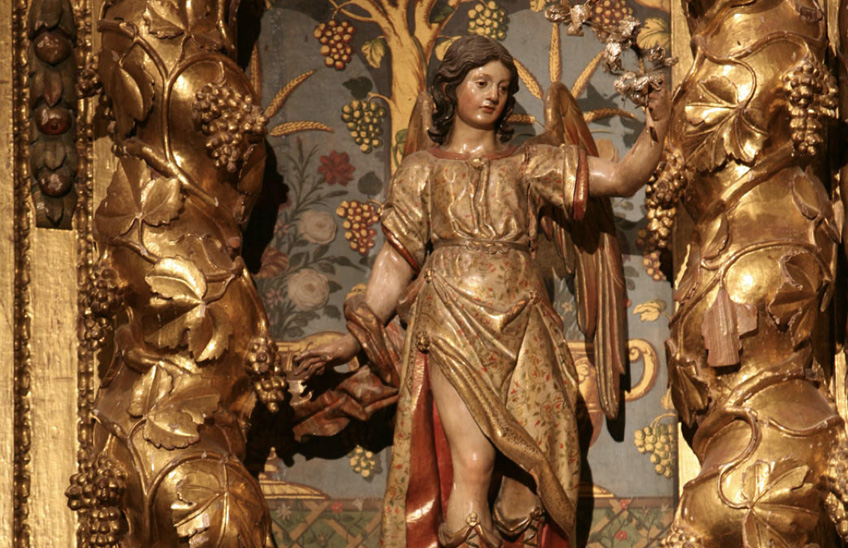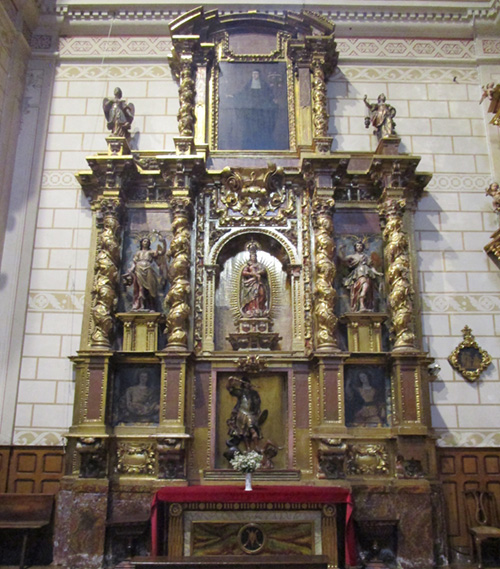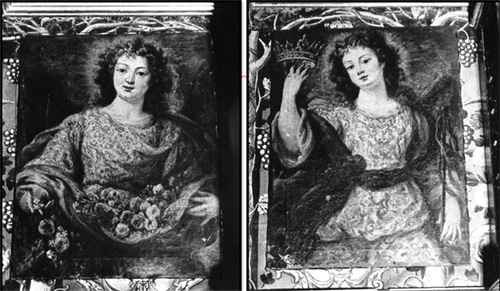An altarpiece with the seven archangels in Pamplona

FotoRicardo Fernández Gracia/San Gabriel, <i>NUNCIUS</i>, en el retablo de la Virgen de las Maravillas de las Agustinas Recoletas de Pamplona.
Since a few decades ago, specifically since the implementation of the novus ordo in 1969, the celebration of the feast of the three archangels St. Michael, St. Raphael and St. Gabriel has been held jointly on September 29. However, until the aforementioned reform, each one had his own commemoration. St. Raphael was celebrated, in the vetus ordo, on October 24 and St. Gabriel on March 18.
In contrast to the popularity of St. Michael, with countless representations in Navarrese art and so many invocations in parishes (46) and hermitages (120), the particular images of the other two are scarce.
In most cases, St. Michael appears as a warrior and triumphant over Lucifer. Sometimes, we find him as a psychopomp, leading the souls and also weighing them in judgment(psychostasis), especially in medieval art.

Altarpiece of the Virgin of the Wonders of the Augustinian Recollect Nuns of Pamplona, 1674.
In the case of St. Gabriel, his appearance is constant in all the scenes of the Annunciation, for obvious reasons. However, in solitary form, it is not usual to find him, although we know of some canvases and sculptures. We will leave the topic of the Incarnation for another occasion, due to its iconographic richness, stylistic diversity and chronological amplitude.
Along with the three archangels that appear in the Scriptures, the presence of four others of legendary and even apocryphal character was abundantly spread since the sixteenth century, based on the finding of a pictorial group in Sicily, in which the seven were depicted, after which a temple was built in Palermo in honor of all of them. A priest of those lands, Angelo del Duca, spread the new devotion in Rome and became a true apostle of it. His perseverance led Pius IV to consecrate the great conference room of the Baths of Diocletian, in 1561, to the archangels, taking as iconographic model what was represented in Palermo. Since then, numerous engravings have spread that particular iconography, especially one by Hieronymus Wierix.

Baraquiel (God's blessing, with white roses) ADJUTOR and Jehudiel (with crown and whip) REMUNERATOR, in the altarpiece of the Virgen de las Maravillas of the Augustinian Recollect Sisters of Pamplona.
In some altarpieces the three canonical archangels appear, but only on one occasion do all seven appear. This last case is the altarpiece of the Virgen de las Maravillas de Recoletas de Pamplona, paid for in 1674 by the canon of Murcia Don Juan Antonio Berasategui, and which underwent modifications to place the archangelic iconography, until fill in the series with sculptures and paintings. In the side streets and in the center of the bench are located Michael, Raphael and Gabriel, in medium-sized sculptures imported from outside Navarre, while the other four are shown in two small lumps that finish off the ends of the attic and in paintings inserted in the side panels of the predella. Michael -victoriosus-, Raphael -medicus- and Gabriel -nuncius- carry their ordinary attributes, sword, fish and lily, respectively. The legendary ones of the canvases are Baraquiel -adjutor or blessing of God-, who appears with some white roses and Jehudiel -remunerator- who is accompanied by a whip and a crown, recalling the award and the punishment. The small sculptures of the attic represent Uriel, the powerful, fire of God, or fortis socius, with a drawn sword and Sealtiel, the praying -orator-, holding a censer, attribute of prayer. In the cloister of the same convent there are two canvases of the aforementioned Jehudiel and Baraquiel.
